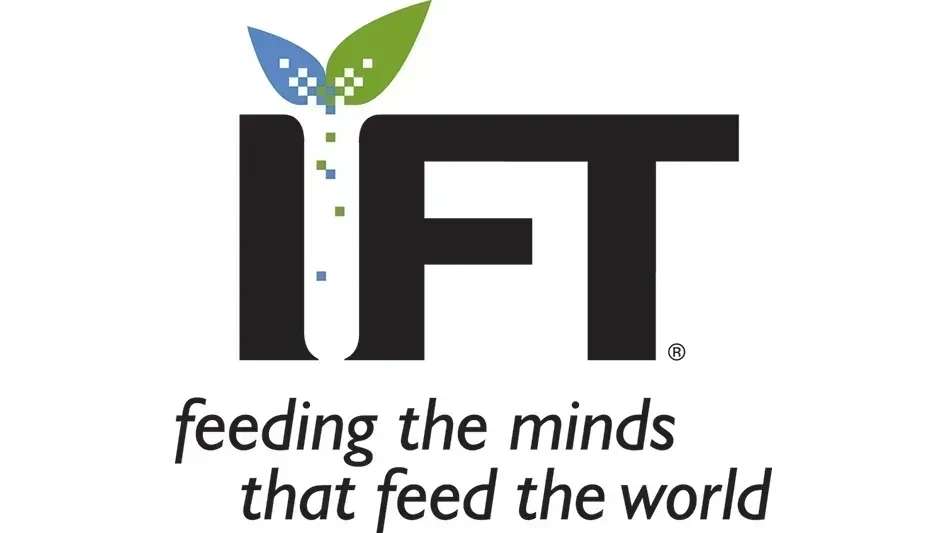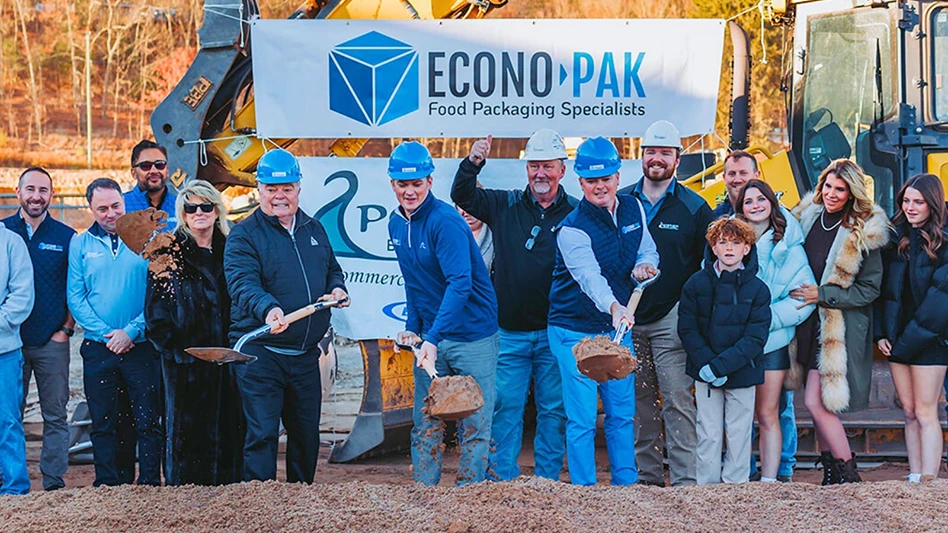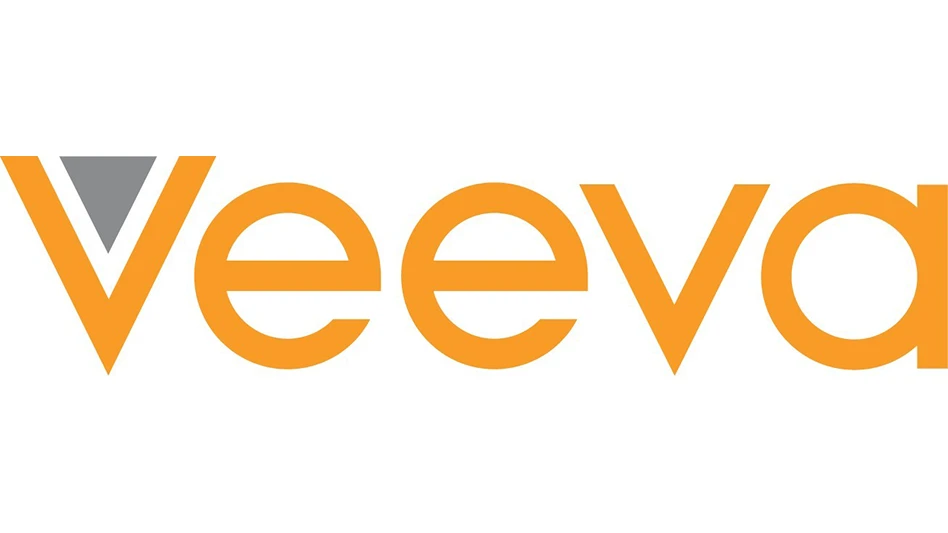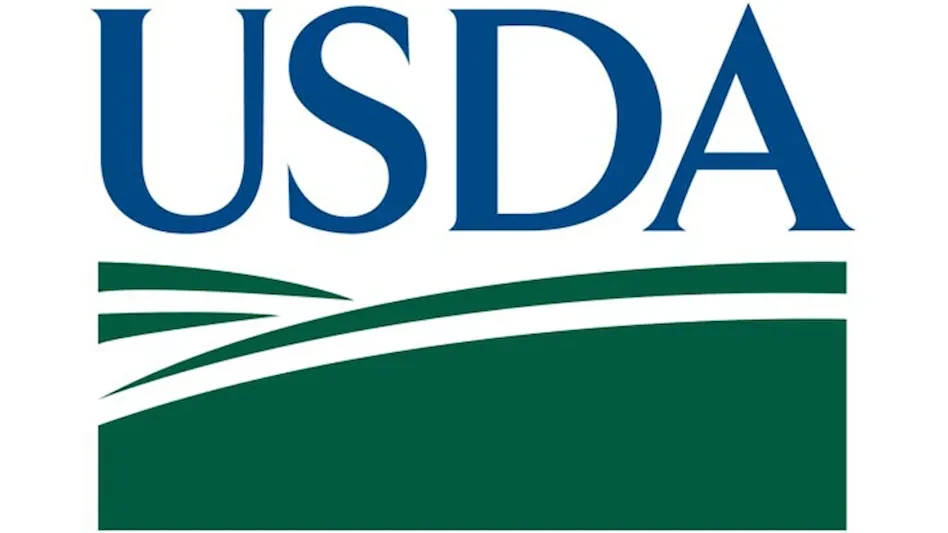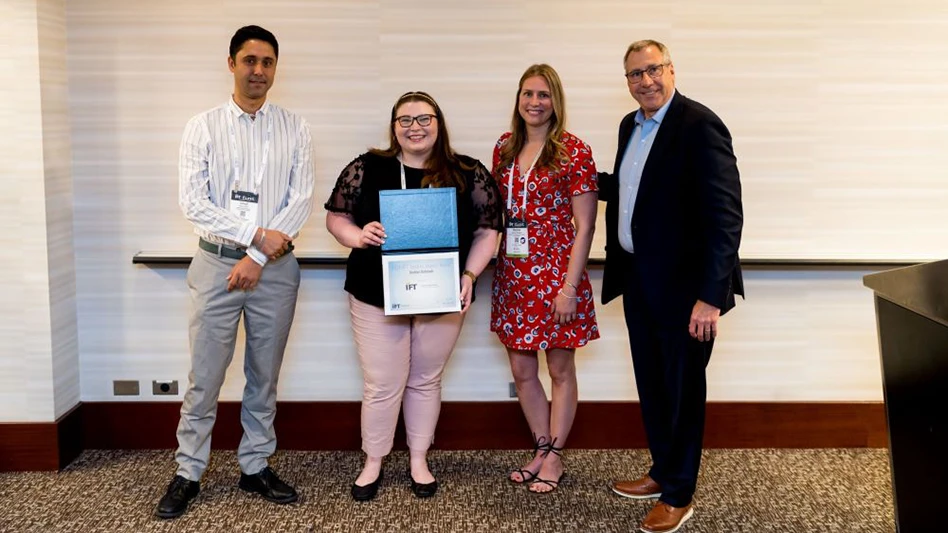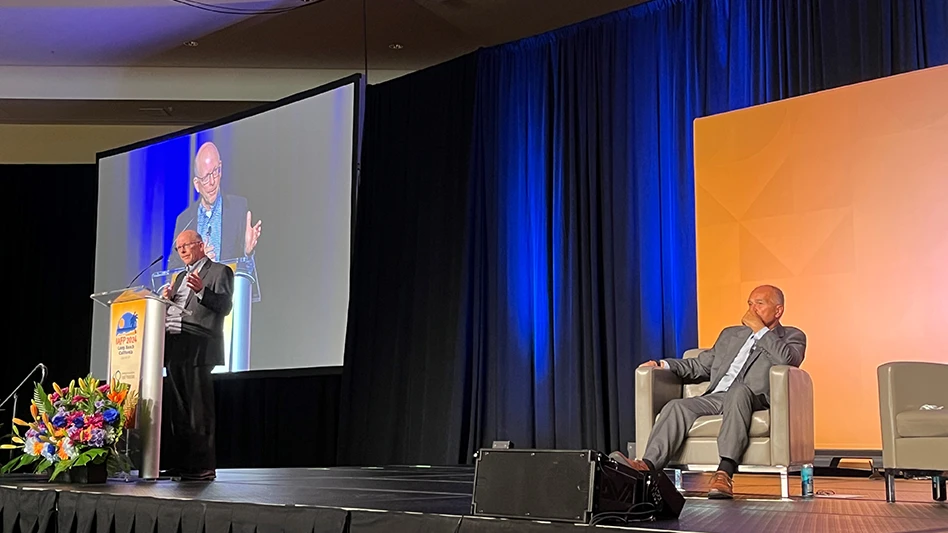
Photos by Jacqueline Mitchell
LONG BEACH, Calif. — The International Association for Food Protection hosted its annual conference, IAFP 2024, from July 14-17 in Long Beach, Calif.
The conference kicked off with an opening session featuring Lawrence Goodridge, a professor and Canada research chair in foodborne pathogen dynamics in the department of food science at the University of Guelph’s Canadian Research Institute for Food Safety. Goodridge presented the Ivan Parkin Lecture, “Digesting Truth: Navigating Food Safety Education in the Age of Misinformation.”
The lecture was followed by a wine and cheese reception and the opening of the exhibit hall, which featured about 150 exhibitors.
REGULATORY UPDATE. During the July 15 U.S. Regulatory Update on Food Safety, Jim Jones, deputy commissioner for human foods at FDA, and Jose Emilio Esteban, under secretary for food safety at USDA, provided updates on their respective agencies.
 Jose Emilio Esteban (l), under secretary for food safety at USDA, and Jim Jones, deputy commissioner for human foods at FDA, take the stage at IAFP 2024.
Jose Emilio Esteban (l), under secretary for food safety at USDA, and Jim Jones, deputy commissioner for human foods at FDA, take the stage at IAFP 2024.Esteban highlighted recent labeling initiatives, including Product of USA, raised without antibiotics, food products derived from animal cells and safe handling instructions labels. USDA recently hired a graphic designer to update the safe handling instructions, introducing more symbols and changing font sizes to make the label easier to read, said Esteban.
Esteban said he has made a few visits to one of the companies authorized to develop food products derived from animal cells in the U.S.
“It is very impressive the progress they’ve made in the last few years,” he said. “…I’m not going to speak to the quality or flavor or anything like that. They did offer me to taste some of the product, but I declined. Not because of taste, but because of perceived bias of me tasting things. But I think that there’s a future for this.”
Esteban also highlighted USDA’s efforts to combat Salmonella in chicken products.
On the FDA front, Jones discussed the agency’s upcoming reorganization, with the new model of a unified Human Foods Program set to be implemented Oct. 1.
“When you go to the [FDA] website and you see the org chart that's posted there with all the new offices that are being created, it's on Oct. 1 that those offices will officially be in place,” Jones said. “And our employees, the people who are going to be in the Human Foods Program, will all be in one of those offices. We're very excited about that. And because I've got such an august audience here, over the next month, a handful or so of executive positions are going to be advertised, so if you have any interest in working with the Food and Drug Administration in an executive position, keep your eyes posted on USAJOBS.”
Jones said that as part of FDA’s Closer to Zero effort, by the end of the year, the agency hopes to finalize an action level for lead in foods commonly consumed by children and propose action levels for arsenic and cadmium in foods commonly consumed by children.
FDA continues to meet with CDC and USDA collaborators multiple times a day to discuss and manage the highly pathogenic avian influenza (H5N1) outbreak, said Jones.
“This may be one of the most collaborative activities of the executive branch I've ever observed in my 30-plus years of a federal service,” he said.
Jones said he remains committed to collaboration and transparency in his role as deputy commissioner for human foods.
“Transparency sounds like it's motherhood and apple pie until you have a painful moment where you're like, ‘We know something that the public doesn't know, but we don't have all the answers if we tell them,’” said Jones. “My position is we're going to tell them, ‘This is what we know, and this is what we don't know.’ Sometimes you really have to say, ‘You know what, we're going to do this,’ because this is going to increase people's confidence in the government by telling them what we know when we know it, even if we don't have all the answers.”

FOOD SAFETY CULTURE SESSION. In the July 15 session “Cultivating a Culture of Food Safety: Key Learnings Toward Food Safety Improvement,” Lone Jespersen, principal at Cultivate, reminded attendees that for food safety culture to continue to mature, it must be a group effort shared by everyone in the company, regardless of position or title.
“Culture lives in groups,” she said. “It’s shared amongst everybody in your companies. And I think that’s something that we really need to take to heart, because in our work, we still see a lot of food safety culture efforts that are being mostly driven by the food safety and quality department.”
Jeff Miller, head of food safety risk management at Mars Inc., said companies need to know where they are in their food safety culture journey before they can determine where they’d like to go.
“We hear time and time again people talking about culture and their journey and saying, ‘Well, we really haven't started, so we're starting with a blank sheet of paper.’ Sorry, you're not,” said Miller. “Unless you're a brand-new business or have a brand-new organization, you have an existing culture. You might not know what it is, and you might not like it, but it's very important to understand that that is your starting point.”
The most important component of food safety culture is visible leadership, Miller said.
“As a leader in your business, I think you need to understand what you say and do matters,” he said. “What you don’t say and don’t do matters as well. And some will argue that might even be stronger than the first. If you’re preaching one thing but practicing another, particularly in front of a large group of associates, that can be really detrimental. And we have a saying that the standard you're willing to walk past is a standard you're willing to accept.”
ADVICE FROM RECENT GRADUATES. During the July 16 session “Transitioning from Grad School to Professionals: Insights from Recent Graduates,” Kaitlyn Casulli, assistant professor in the department of food science and technology at the University of Georgia and graduate of Michigan State University, said graduate school is where she learned to be herself and to navigate conflict and difficult situations.

From l-r, recent gradautes Olivia Haley, Kaitlyn Casulli, Jasmine Kataria, Sonali Sharma and Pranav Vashisht discuss their transition from school to industry.
“Find good students, good managers, good collaborators and really build those teams of people that you know are going to value you, and put those boundaries up when you know someone is maybe not valuing your work or valuing who you are as a person,” she told the students in attendance. “Do not let people push you around, whether it's now in graduate school or out in industry or academia or government. You are a valuable person. You are here in graduate school. You're doing great work. And there's a reason why you got into the program you're in.”
Olivia Haley, postdoctoral fellow with the USDA Agricultural Research Service and graduate of Kansas State University, shared the key to her transition from studying agronomy to learning about food science at a food micro testing lab.
“Don't underestimate the value of your enthusiasm and your willingness to learn, because if there's a position that you really want to take up, as long as you're willing to learn, I think many places are willing to give you a chance,” she said. “… When you have your master's, you already have so many skills that other companies are looking for. You know how to execute protocols; you know how to form your own protocols. It's really about what skills you picked up, not necessarily just your expertise.”
FSMA TRACEABILITY SESSION. In the July 16 session “Leveraging GS1 Standards and Advanced Data Carriers to Support FSMA 204 Traceability Requirements,” Alex Hoang, FSQA manager at Chipotle Mexican Grill, discussed traceability challenges his company faces, including unique case scanning, bar code readability, traceability lot code source and limited understanding of FSMA 204 from suppliers.

"The silver lining to it is we have solutions," he said.
For Chipotle, one of those solutions has been the use of RFID (radio frequency identification).
"It makes doing the right thing the easy thing," said Hoang.Renee Perry, vice president of corporate social responsibility and ESG at Culinary Collaborations LLC, a sushi ingredient company, said that with FSMA 204 on everyone’s minds, it’s important for companies to simply start where they are.
“Start with what you have,” she said. “Get that master data correct — when we talk about product data and really identifying things, maybe your location and your item numbers — and then look at how it's flowing through your particular supply chain. Then work one up, one back. How can we get to traceability? What are we missing?”
Latest from Quality Assurance & Food Safety
- Multistate E. coli Outbreak Linked to Iceberg and Romaine Lettuce Blend
- FDA, USDA Seek Information About Food Date Labeling
- William Marler, Food Safety Advocate and Lawyer, Condemns Lack of Safety of U.S. Food Supply
- AFDO Infographics Illustrate State-Level Impact of FDA’s Proposed Budget Cuts
- Multistate Outbreak of Salmonella Typhimurium Linked to Cucumbers
- USDA Begins National Milk Testing Strategy to Address H5N1 in Dairy Herds
- USDA Announces Grain Inspection Advisory Committee Appointments
- Eagle Product Inspection Highlights FA3/M Fat Analysis Machine for Meat Inspection
